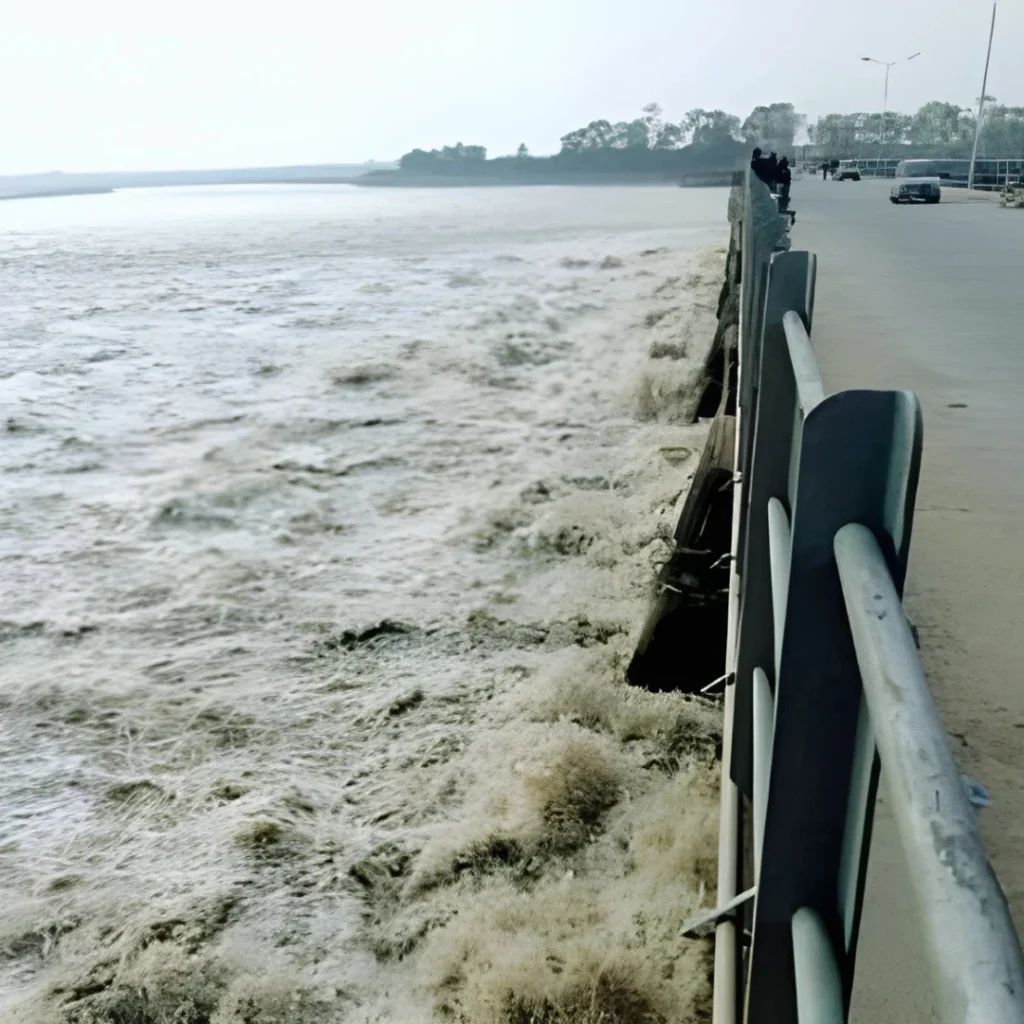Sutlej River is among the most significant rivers in Pakistan that pass through Punjab, and eventually join the Chenab before eventually flowing into the great Indus. This river is the focus of attention in 2025 since it is witnessing unprecedented floods, large inflows and significant destruction of agriculture and settlements. Millions of people are at risk that current situation has put, and thus it is one of the greatest humanitarian and environmental challenges over the last few years.
Sutlej River Pakistan Update Today Water levels in the river have been established to be critical in numerous headworks and emergency arrangements have been made. The article gives a precise description of the current state of affairs, causes of the floods, government intervention, people and economic effects, and historical value of the river Sutlej.
Latest Updates – River Flow Levels in Punjab
As per real-time observation, the Sutlej River is at very high levels of floods at major points of control like Ganda Singh Wala, Sulemanki and Islam Headworks. High amounts of water discharged upstream in conjunction with heavy monsoon rainfall have taken the river way beyond its comfort zone.

Current Flood Status at Major Sites
Sutlej River Pakistan Update Today!
| Location | Flow (Cusecs) | Status | Impact on Region |
|---|---|---|---|
| Ganda Singh Wala | 300,000+ | Exceptionally High | Mass evacuations, villages flooded |
| Sulemanki Headworks | 130,000+ | High Flood | Agricultural land submerged |
| Islam Headworks | 100,000+ | Rising Levels | Irrigation canals overflow risk |
| Panjnad Confluence | 310,000+ | Very High Flood | Mixed flows from Sutlej, Chenab |
Those statistics indicate that the river is facing the pressure, never been seen before, which has to be constantly observed. Downstream areas are the most affected and the flood water continues to flow to southern Punjab.
Causes of the Flood Situation
The cause of the present flood crisis on the Sutlej River has many reasons. Maryam Nawaz Salary Update 2025.
- Heavy Monsoon Rains- Punjab and North India received more than normal rain this year, which augmented runoff into river system.
- Releases of Dam – Big releases of water off upstream reservoirs have contributed to abrupt increases to the Sutlej.
- Climate Change –There is increased uncertainty in weather patterns, which increases rain fall events and reduces the time between floods.
- Soil Saturation – Ongoing rain has flooded the fields and they can absorb very little water and thus the water flows directly into the river.
A combination of these factors has resulted in one of the worst floods that have hit in recent history.

Evacuations and Emergency Measures
The Punjab government and disaster management authorities have gathered mass evacuation efforts. Families who live by the banks of Sutlej are being relocated to safer areas and relief camps in thousands. Children Rescue boats, military units and volunteers are operating around the clock to reduce human casualties.
Relief camps were made where there is food, water and basic medical supplies. Governments have also established vet-units to rescue cattle, which is an important commodity to rural households. These activities have not been able to contain the sheer magnitude of the flood rendering relief operations extremely difficult.
Humanitarian Impact – How People Are Affected
Millions of people in Punjab have been displaced by the floods. The families are staying in temporary shelters, school premises and open fields till the water subsides. The most vulnerable are children and elderly people because they either experience a health problem, malnutrition and psychological trauma because of sudden displacement.
Lots of the villagers have lost not only their houses, but also their standing crops and animals. Communities are under observed to be dependent on government aid and donations by welfare agencies due to scarcity of resources.
Agriculture and Economic Losses
Punjab is referred to as a breadbasket of Pakistan and the Sutlej is very important in irrigating its fertile lands. On the negative side, floods that have happened this year have swept away thousands of acres of crops such as rice, cotton, sugarcane and maize. Farmers are suffering massive losses as months of hard labor is washed away in one night.
The damage to agriculture is not just a rural issue; it will have nationwide consequences. Reduced crop production means food shortages, higher prices, and increased burden on the economy. The agricultural exports of Pakistan may also be affected if the damage continues in the coming weeks.
Infrastructure and Transport Challenges
There have also been large-scale destruction of infrastructure due to floodwaters. Highways, bridges and railway tracks in southern Punjab have been flooded, isolating towns and villages with main cities. In various places, power supply systems have fallen down, which deprives people of power supply over days.
There will be huge monetary investments and time wastage to restore the infrastructure. Up to that moment, there are still limited relief operations due to the blockage or insecurity of transport routes. This has hampered food, medicine and rescue provision.
Health Risks and Medical Concerns
Floods are usually accompanied with eruption of water borne diseases and the case is no exception in the Sutlej. Poor sanitation, lack of clean drinking water and stagnant water have played a role in increasing the chances of cholera, diarrhea, malaria and dengue fever.
There has been the establishment of medical camps and the number of people seeking healthcare services is too high. Physicians are alerting that the number of people who risk their health may skyrocket in the next few weeks unless preventative measures are undertaken.
Emergency Preparedness – What People Should Do
To stay safe during the flood emergency, citizens are advised to follow these steps: Punjab Minority Card 2025 Application Guide.
List: Safety Guidelines for Communities
- Keep up With It – Hear official announcements and do not rely on rumors.
- Evacuate Early- Relocate to safer locations when there are warning signals by the authorities.
- Protect Essentials – Store identification documents, medications, and the valuables in waterproof bags.
- Avoid Riverbanks – Not to cross flooded roads, canals or bridges.
- Help Others – Assist the elderly, women and children with evacuation.
Using such guidelines, people can have the opportunity of risk minimization and protection in the situation of crisis. For more latest news and updates on schemes and results, visit the UrduJankari .
Historical Significance of the Sutlej River
Sutlej is not only an economic lifeline but it has great historical significance. It has been a member of ancient civilizations, trade paths and cultural practices in Punjab. The river has undergone wars, transgression, and settlements over centuries.
The Sutlej later joined the Indus Waters Treaty between Pakistan and India in modern days. This treaty controlled the two-country flow of rivers. Nonetheless in 2025, political stress has complicated water-sharing agreements which has brought a new dimension of uncertainty to water security in Pakistan.
Strategic Importance for Pakistan
The Sutlej River has other significant strategic significance besides agriculture. Its dams such as Sulemanki and Islam are very important to regulate water to the southern Punjab. A disruption in its flow will have a direct impact on irrigation, power production and flood management.
The river is also sensitive in terms of its geopolitical location since it borders India. The management of this river needs more than the technical solutions but also the regional level of diplomatic cooperation.
Future Concerns and Climate Change
The present flood crisis shows an issue of a larger scale climate change. Pakistan has already been pointed out as one of the most susceptible nations to global warming. The temperatures are also increasing the strength of rainfalls, melting of glaciers and unpredictable weather.
The rivers like the Sutlej are going to continue to create disasters unless long term strategies of adaptation are put in place. The future needs building of dams, improved irrigation and stronger flood control mechanisms.
Government Response and International Support
With the assistance of the armed forces, the government of Pakistan mobilized all possible resources in flood relief. The international organizations are also committing to offer aid, the magnitude of the crisis being understood. Nevertheless, analysts reckon that along with temporary remedies (including climate resilience initiatives, enhanced river management, and infrastructure planning) Pakistan requires long-term remedies.
Conclusion
The 2025 Sutlej River flood is an eye-opener to the influence of nature and the susceptibility of cities. Even though emergency response is yet to be developed, the long-term issue is to prepare these similar events in future. One of the investments that are critical is water management, disaster preparedness and climate adaptation.
In the meantime, all the attention is paid to save lives, communities and reconstruct what was destroyed. Punjab nation has endured a lot of suffering and yet they have managed to be resilient and united in this crisis.







